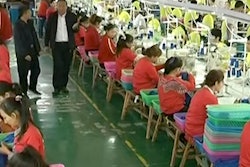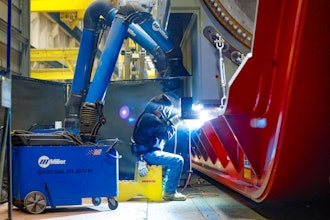Karl Lagerfeld once remarked that “one is never over-dressed or underdressed with a Little Black Dress.” A simple statement, yet one that caused the Little Black Dress (LBD) to be a staple item in women’s closets across the globe. And while the LBD is still a must-have for consumers, apparel manufacturers are embracing a slightly different fashion statement for their employees: wearables.
Wearables are transforming the way that manufacturers manage their operations, helping with everything from inventory allocation to customer service. And, with IDC predicting that wearable device shipments will increase to 240 million in 2021, the impact from these connected devices will only grow in the years to come.
If you haven’t added wearable technology to your workforce yet, you may want to research how these devices are adding value to your operations. Below are just some of the benefits that wearables offer.
Perfecting the Logistics Side of the House
Of late, wearables have taken the manufacturing industry by storm. According to IDC, “the proliferation of advanced, purpose-built, analytic applications aligned with IoT will result in a 15 percent increase in productivity improvements for manufacturers.” This is especially true when it comes to storing, shipping and tracking items in the warehouse. For example, if there is a service disruption or mechanical problem, engineers can troubleshoot remotely via smart glasses. Additionally, company’s such as Honeywell are creating Bluetooth-wearable scanning devices to improve efficiency and productivity of scan-intensive tasks in warehouses.
On a larger scale, many smart factories are being built with the Industrial Internet of Things (IIoT) and wearable technology in mind. These factories are creating sensor-enabled equipment and systems that connect back to wearable devices. With data being collected from a variety of sources—everything from assembly lines, forklifts and smart gloves—and delivered to a central system, manufactures can make data-driven decisions about how to improve their overall operations.
Tackling the Inventory Issue
Manufacturers are always on the hunt for better ways to manage inventory—and wearables offer the perfect hands-free solution. Smart glasses are one of the most popular wearable options in warehouses, notifying workers about what is happening on the floor and allowing them to have visibility from a remote location. Ring scanners and other such devices make staff productive, reducing the amount of time to scan products. Wearables can be connected to the manufacturer’s ERP software, providing the company with real-time updates on inventory and progress. By removing the need for handheld devices and laptops, manufacturers are able to find, store and move products more quickly and effectively.
Making Collaboration a Reality
In the era of omnichannel operations, manufacturers are still struggling to ensure all of their departments are working together. With wearables, this type of collaboration becomes infinitely easier. Take the Product Lifecycle Management (PLM) process, for example: During the design phase, connected devices, alongside augmented reality and virtual reality (AR/VR), can be used by technical product developers, designers and their offshore factories to collaborate on projects, reducing time it takes to iterate through physical samples and thus significantly improving concept-to-shelf time.
Manufacturers can also use smart watches to share data and photos in real-time, ensuring everyone has visibility into the full project. Other tools to help workers be less restrained include wearables that work by gesture controls or voice input. And earlier this year, Amazon received a patent for a wristband tracking system, which can free warehouse workers from using hand-held devices.
Keeping Pace With the Customer
Today’s consumers have steep demands and expectations for fulfillment. Professionals working in warehouses or distribution centers are embracing wearables as way to meet these demands, especially when it comes to fulfilling urgent, same-day orders. These professionals are also adopting IoT technologies to assist with decision-making within product design and development.
Connected devices can share up-to-the minute data on customer preferences, allowing companies to modify their designs during the manufacturing process. At the store level, there are hearable devices that allow for immediate communication between employees, removing time wasted in tracking each other down. AR/VR can also aid field support staff. By having them use smart glasses or tablets, they can connect to the back-office experts in real time for diagnosing and resolving issues. It is far more cost-effective and scales the business to improve customer support.
Putting Employee Health and Safety First
Wearables are most famous for improving individual health and wellness, which is an important part of most manufacturing and warehouse operations as well. Caterpillar created sensors that monitor fatigue to avoid accidents and has tapped into additional wearables to keep employees safe and aware. Fitness trackers are one of the most common wearable devices, offering a way to follow employees’ health and reduce potential on-site accidents. For manufacturers that want to protect the safety and welfare of their employees, wearables should be first on their 2019 purchase list.
It’s expected that by 2020, more than 75 million wearables will permeate the workplace. For manufacturers, these devices won’t just be part of the workplace—they will be a piece of their success story. Don’t wait for a fashion icon to make wearables the official LBD for manufacturers. Add them to the wardrobe of your workforce today.
Ajay Chidrawar is Vice President of Global Product Management & Customer Success at CGS.





















